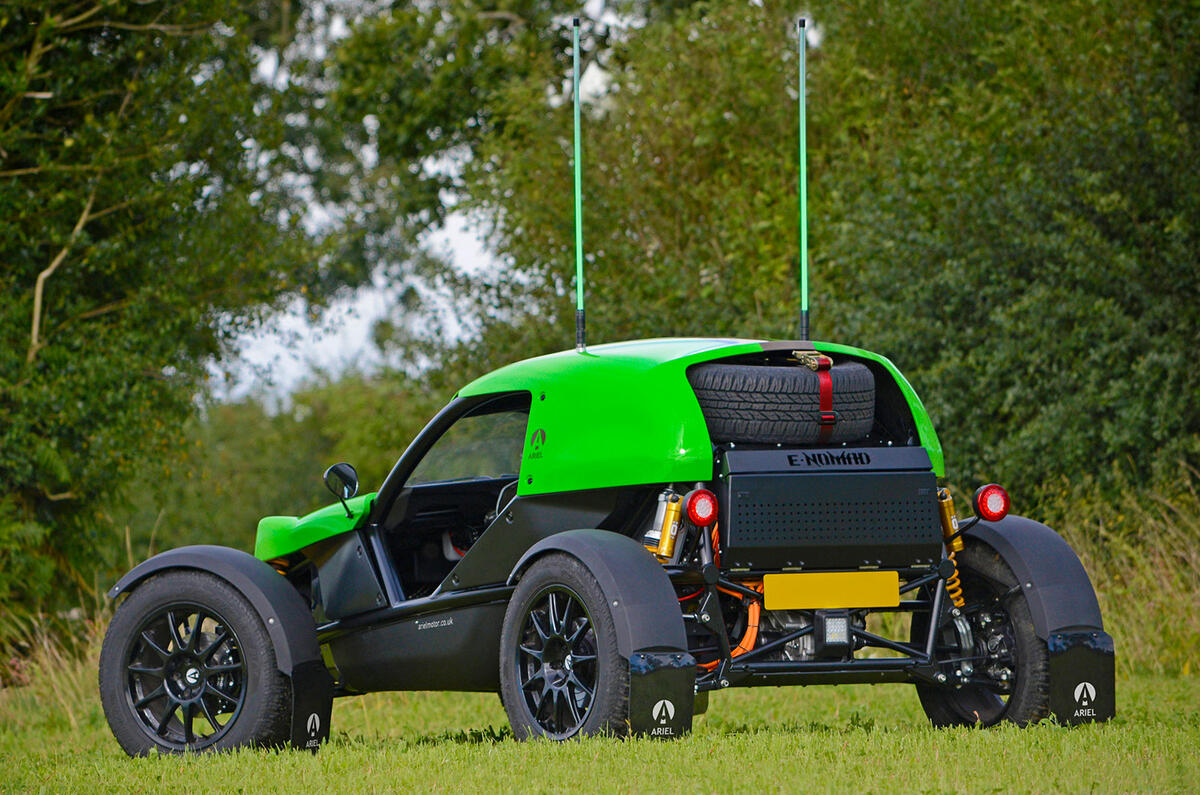Somerset-based Ariel has revealed a near-production-spec concept that previews an electric version of the Nomad 2, the performance off-roader that was itself unveiled only last month.
Dubbed E-Nomad, the new car will provide similar performance to the ICE model while offering unique driving attributes.
Ariel says the electric car is “already on the way” and plans to launch it in 2026. It would cost around £10,000 more than the £68,000 Nomad 2, Ariel CEO Simon Saunders has told Autocar, with battery costs the key to final pricing.
The new EV is the focus of a three-partner project called ZELV (Zero-Emissions Lightweight Vehicle) and the concept will be officially unveiled on 4 September at the Millbrook technical centre, Bedfordshire, as part of the Low Carbon Vehicle Event.
Saunders firmly believes low-volume manufacturers must embrace the electric future or risk being left behind. The E-Nomad aims to show how new technology can be adapted to other low-volume EV projects.

Built with the assistance of two British-based partners, Rockfort Engineering and BAMD Composites, the E-Nomad is backed by a £300k government Advanced Propulsion Centre grant.
It uses the same steel spaceframe chassis and all-independent suspension as the Nomad 2 and has a similar rear-wheel-drive layout.Power comes from a BorgWarner water-cooled single drive motor that delivers 281bhp and 360lb ft.
Several prototypes have already been built and Ariel is confident that a battery-powered model can have a 115mph top speed and achieve 0-60mph in 3.5sec.
Moreover, Ariel engineers predict new benefits in off-road use from the precise delivery of the E-Nomad’s huge bottom-end EV torque and the practical possibility of single-pedal driving.
The E-Nomad is designed with both regenerative braking and a new-to-Ariel ABS system. In a developed version of the car, further tuning could produce a power output of 324bhp.
Its powertrain consists of a Cascadia Motion iDM 190 drive unit that combines the motor, one-speed gearbox and inverter in a single unit, mounted just ahead of the driven rear wheels. The entire unit weighs only 92kg.
The advanced lithium ion battery pack and its tunable control software is designed specifically for the E-Nomad by Rockfort. The capacity of the 450V battery is 41kWh and it uses 12 Pegasus V3 modules, which are claimed to set new standards for energy density. The whole assembly weighs less than 300kg, one big reason why the E-Nomad’s kerb weight is a modest 896kg.

The battery, sited behind the rear bulkhead to optimise weight distribution and minimise cable runs, has a sophisticated cooling/heating system to cope with “energetic” off-road and track use.
The lightweight body is made of a natural-fibre bio-composite from the project’s third partner, BAMD. It features long, continuous cellulose fibres from flax plants that give high tensile strength and stiffness. The material’s manufacture saves more than 70% of the CO2 output of rival composites.
In a production E-Nomad, the bodystyling would be further developed, but Saunders says a clear emphasis on aerodynamics would be a continuing theme.
Ariel will assess reaction to the idea of an electric Nomad when it gets to Millbrook but is confident that, with further development, the model can offer a different driving experience from the ICE model. “We want the battery car to be able to do things the petrol one can’t, and vice versa,” said Saunders. “That justifies both.”
Q&A Simon Saunders, CEO, Ariel
It’s likely small manufacturers like Ariel will get exemptions from the 2035 ICE sales ban, so why build an EV now?
“Many people say our tiny number of cars is never going to affect global pollution and that’s probably right, but I still think we have to do our bit. Two other things: if we’re not careful, we’ll simply run out of engines. And if we stay where we are, we risk others doing things better and leaving us behind.”
Can EV models like yours eventually be better than the ICE versions?
“I believe they can. I keep telling our Ariel team that electric cars need to become the better choice, and I’m convinced they can be, and companies like ours can move faster than most. I believe it will be the same for autonomy. That can also make cars better.”
You have used an EV power unit anyone can buy. What’s the rationale behind that?
“We were keen this time to use appropriate existing components to meet our first priority: dependability. People think we should be putting performance first – and it’s certainly up there – but it’s not much use if the car doesn’t deliver.”
Why are batteries so expensive? We thought costs were coming down…
“It’s the low-volume thing, the lack of scale. In our case, it’s not the supplier but the materials cost. If you want something good in small numbers, you have to pay.”





























Join the debate
Add your comment
This is more like it! There is a cavernous gap in the market where EV sports cars and off-roaders should be.